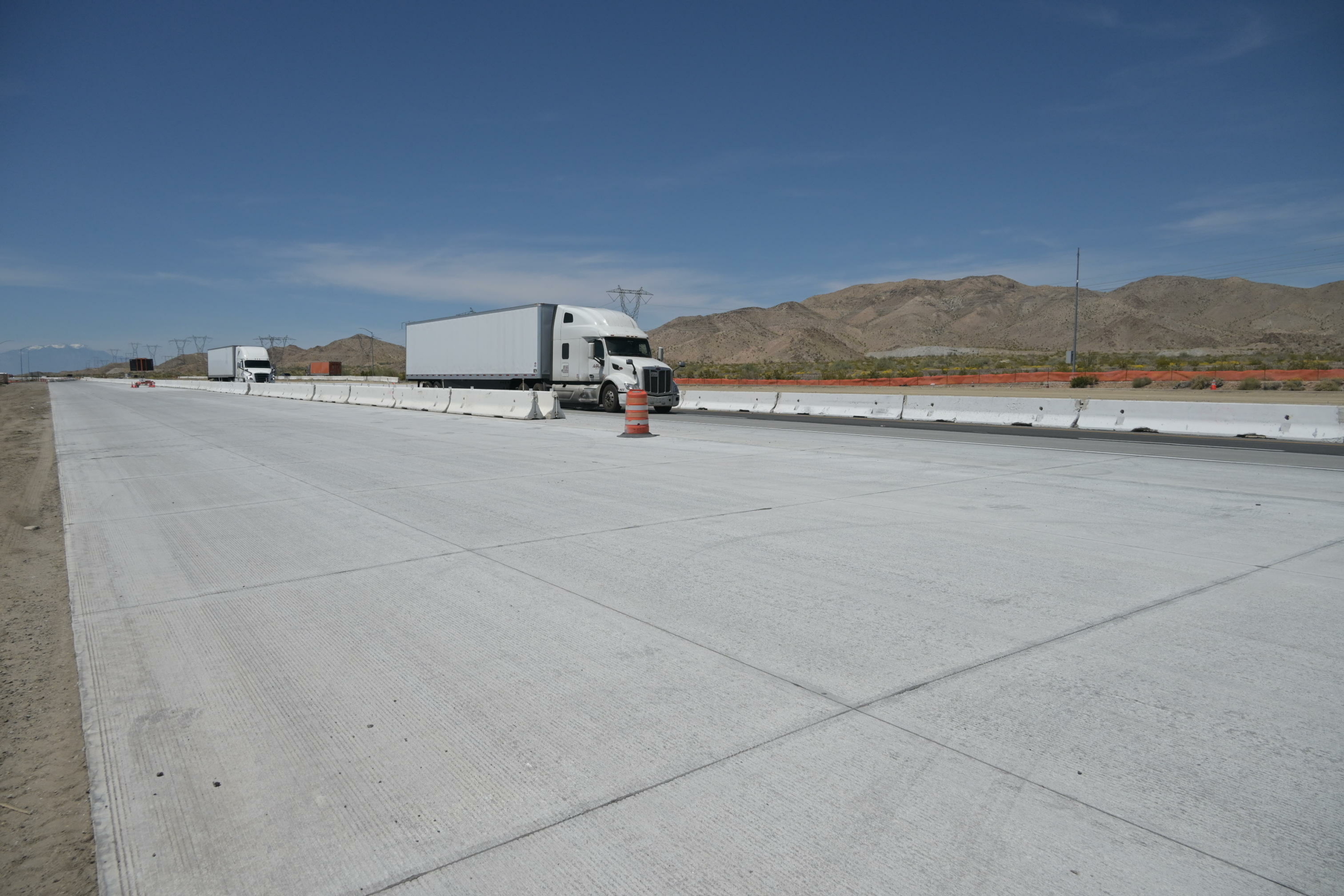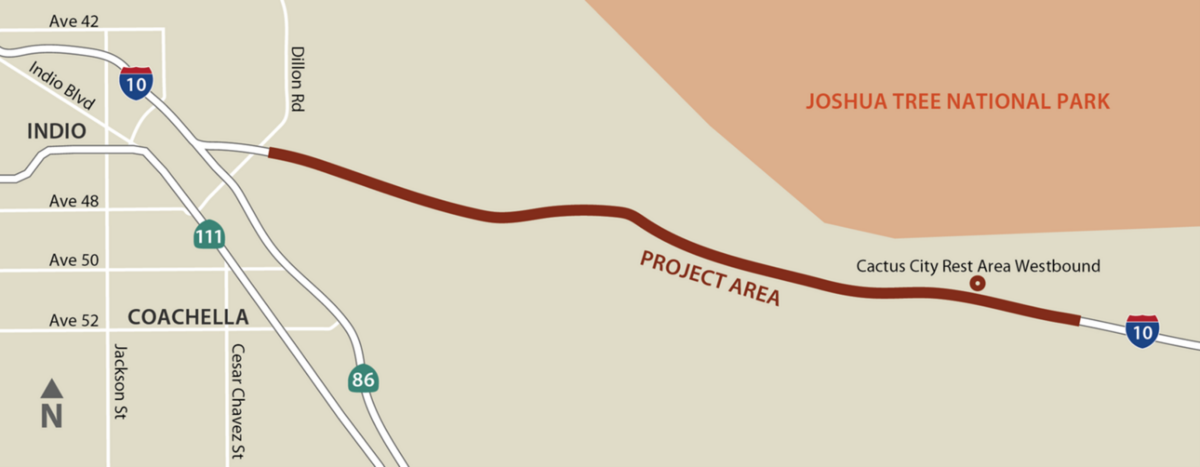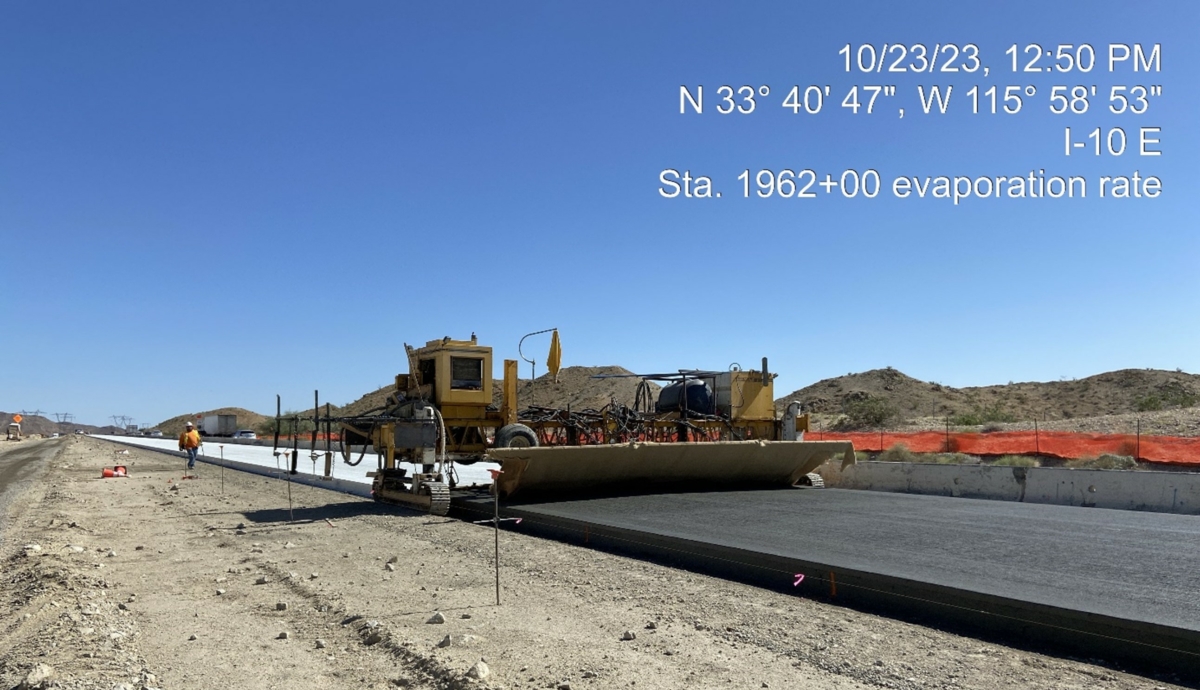Caltrans District 8 is engaged in a multi-year effort to rehabilitate Interstate 10. The earlier I-10 Tune Up Pavement Rehabilitation Project encompassed 20 miles of the freeway from Beaumont to State Route 111. The subsequent and ongoing $241-million I-10 Blythe Pavement Rehabilitation Project covers 30 miles of the interstate from Desert Center east to Wiley’s Wash, about 15 miles west of Blythe, with concrete pavement work taking place on 88 lane miles. (https://swcpa.org/coffman-travels-east-to-rehab-desert-stretch-of-i-10/)
Now, work is underway on a third segment of Interstate 10 east of Coachella in Riverside County, just south of Joshua Tree National Park. Caltrans District 8 Materials Engineering conducted site-specific field exploration and lab tests that led to the recommendation of reconstructing this section of I-10 with jointed plain concrete pavement (JPCP) in a combination of full-depth reconstruction and concrete overlay. An option to rehabilitate the asphalt pavement was rejected after performing a Life Cycle Cost Analysis.
Spanning 13.6 miles of freeway, the I-10 Desert Rehab Project includes both eastbound and westbound pavement rehabilitation, the construction of a new eastbound truck-climbing lane, and the installation of solar-powered electric vehicle charging stations at the Cactus City Rest Area. Additional infrastructure work includes grading in the median to create a 30-foot Clear Recovery Zone (CRZ), replacing and upgrading bridge railings, installing new guardrail systems and roadway signage, and improving the drainage and stormwater treatment systems. The improvements will extend pavement service life, and improve safety and mobility throughout the alignment.
Spanning 13.6 miles of freeway, the I-10 Desert Rehab Project includes both eastbound and westbound pavement rehabilitation, the construction of a new eastbound truck-climbing lane, and the installation of solar-powered electric vehicle charging stations at the Cactus City Rest Area. Additional infrastructure work includes grading in the median to create a 30-foot Clear Recovery Zone (CRZ), replacing and upgrading bridge railings, installing new guardrail systems and roadway signage, and improving the drainage and stormwater treatment systems. The improvements will extend pavement service life, and improve safety and mobility throughout the alignment.
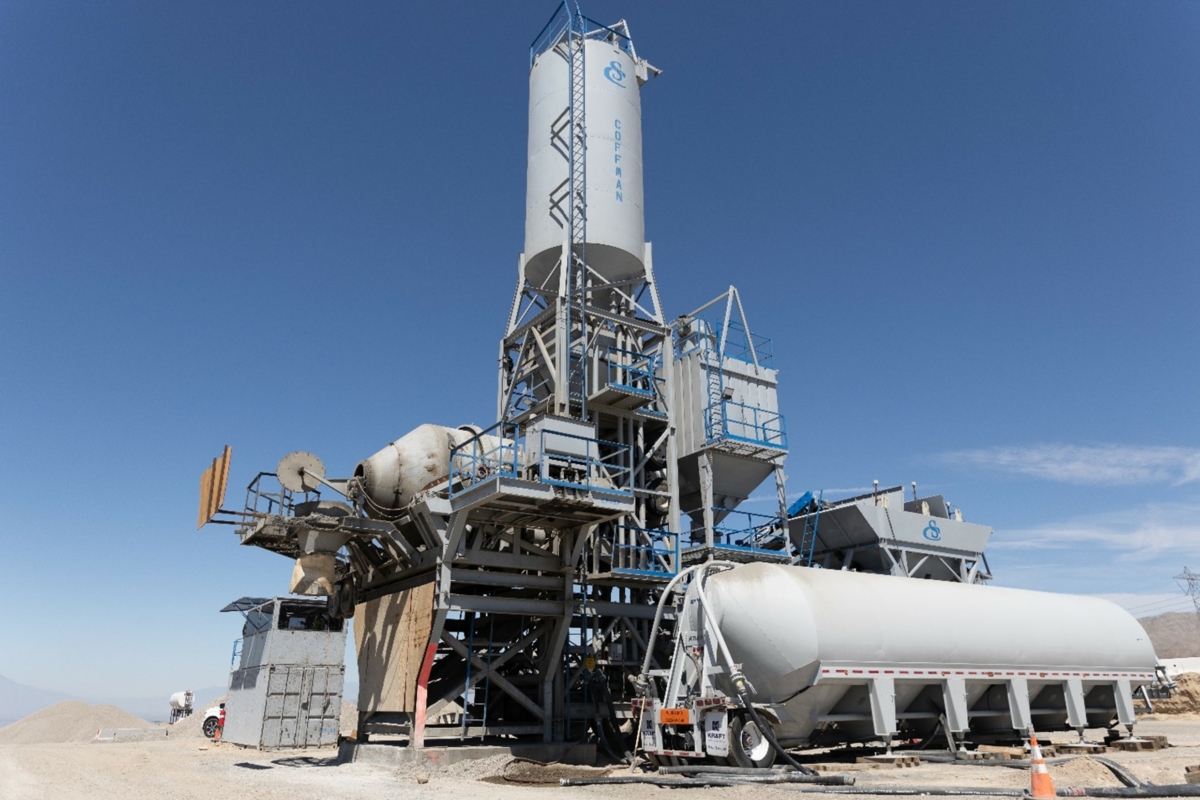
Coffman Specialties erected a batch plant onsite to produce the concrete for the JPCP. Photo courtesy of Thomas Reese, Arellano Associates.
The work by Caltrans and Coffman Specialties starts 1.8 miles east of the Dillon Road Interchange and extends to two miles east of the Cactus City Rest Area. This section of I-10 is a major east-west connector route and an Essential Freight Corridor and the pavement was designed to withstand the heavy loading over 40+ years with minimal maintenance.
Coffman Specialties is the Construction Manager and Prime Contractor on the project, the lead designer is T.Y. Lin International, and the contract value is $188,155,000.
Divyesh Vora is the Caltrans Area Corridor Manager and Sadique Hossain is Caltran’s Construction Engineer/Senior Resident Engineer on the project. Mitch Gamache is the Coffman Specialties Project Manager.
The project is being built in four stages. Stage One began in spring 2023, and focuses on improving highway safety and widening the road to accommodate the new truck-climbing lane. The stretch of eastbound I-10 that will get the new truck-climbing lane is being widened into the median, and a new traffic lane is being added to the interior of the roadway. This will enable the outside lane to become a dedicated truck climbing lane. Both the new inside lane and the new 10-foot inside shoulder are being constructed with JPCP. In total, more than 225,000 cubic yards of JPCP are going into the project.
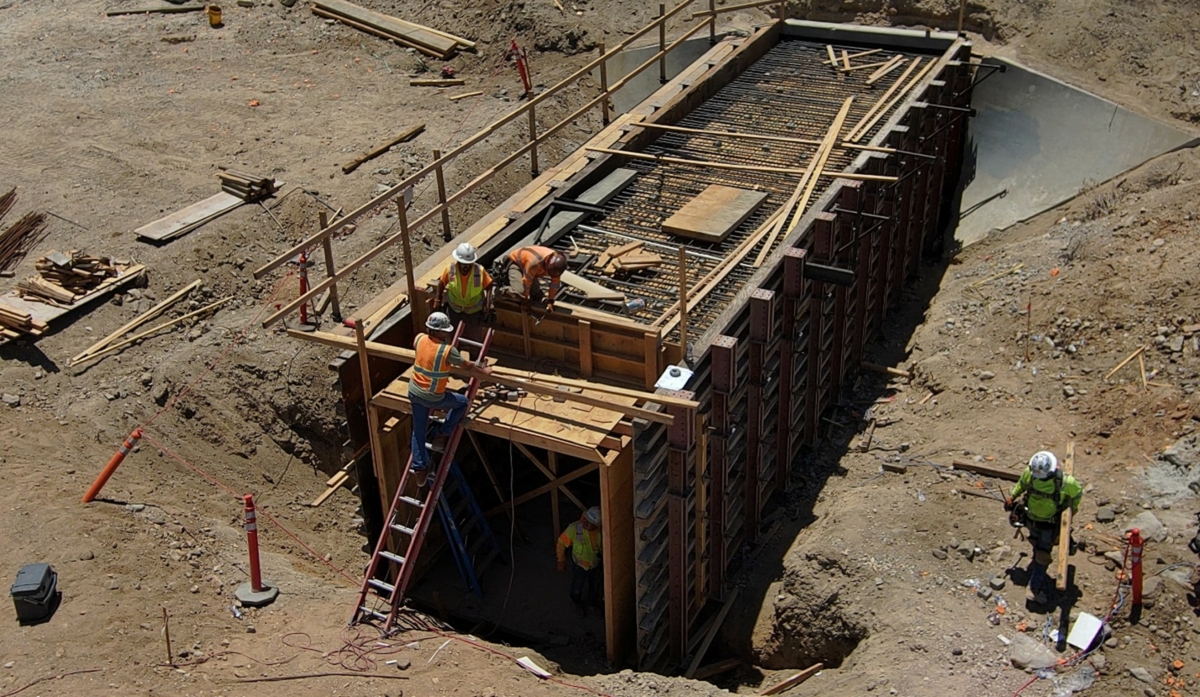
The Coffman Specialties crew works on forming the extended median drainage passageway. Photo courtesy of Thomas Reese, Arellano Associates.
Work in Stage One to reconfigure the roadway includes extending the median drainage and building the eastbound side of the Clear Recovery Zone (CRZ), which involves grading the median and creating a new 10-foot inside shoulder. Safety improvements include replacing the existing metal beam guard rail with the Midwest Guardrail System. Targeted completion for Stage One is summer 2024.
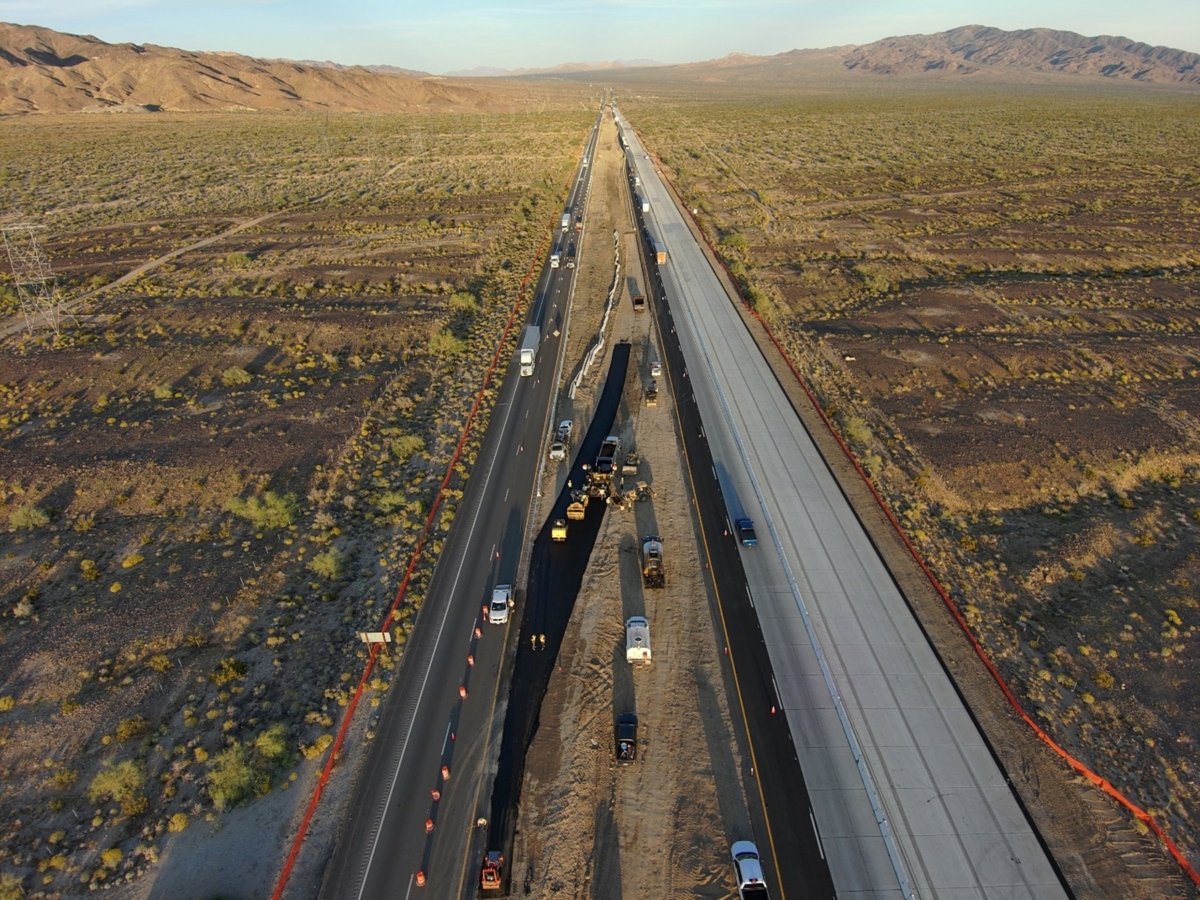
Crossover lane construction takes place to shift traffic onto the newly paved JPCP during Stage Three of the project. Drone photo courtesy of Sadique Hossain, Caltrans.
To prevent the native Desert Tortoise from traveling into the work zone or onto the freeway, exclusionary fencing has been installed as a preventative safety measure. The orange fencing can be seen in the above photo.
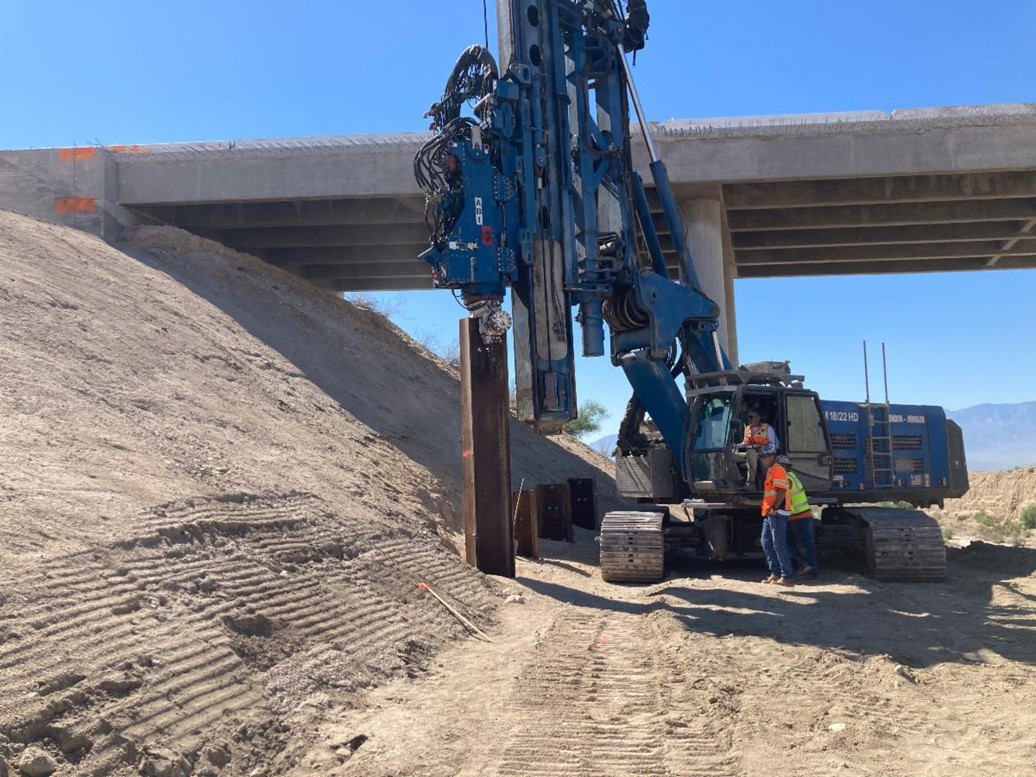
Steel piles are driven into the ground as the foundation for new support columns for the I-10 bridge widening. Photo courtesy of Thomas Reese, Arellano Associates.
The new additional lane requires nine bridges along the eastbound alignment to be widened 28 feet, with new support columns being constructed to accommodate the expanded roadway. These nine bridges, along with the nine westbound bridges, will have their barriers replaced to meet current standards, receive new approach slabs and joint seals, a polyester concrete overlay, and column seismic retrofits. Bridge scour mitigation will be accomplished by placing partially grouted rock slope protection along the nine major washes.
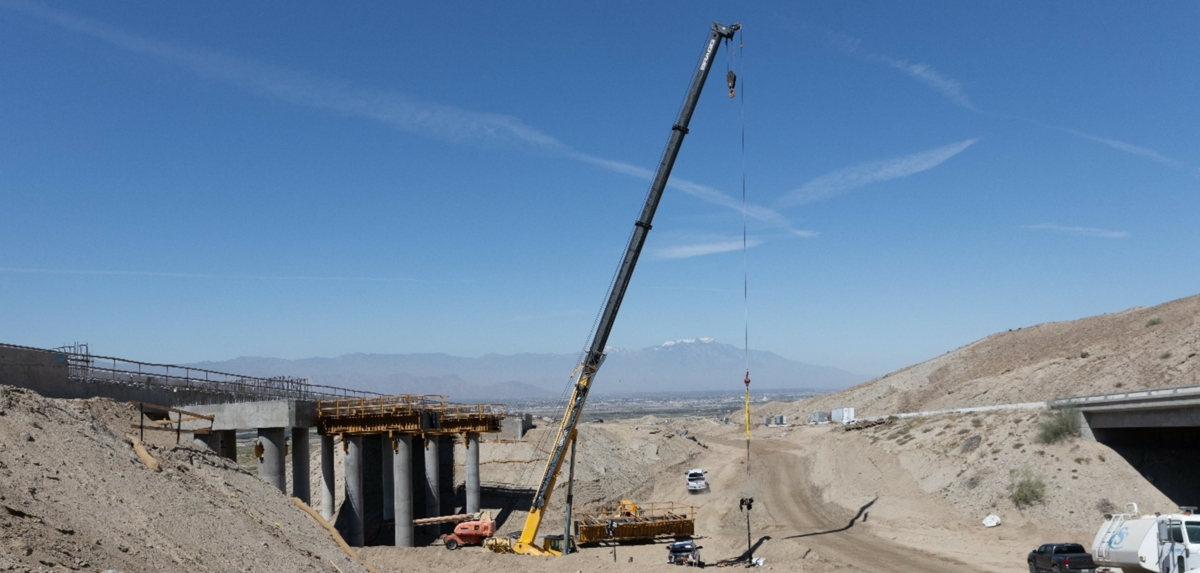
The support structure for the new bridge portion takes shape. Photo courtesy of Thomas Reese, Arellano Associates.
Starting this week, eastbound traffic was shifted into the Stage Two alignment, towards the median and onto the newly added eastbound lane for the eastern half of the project, allowing for the reconstruction of the eastbound pavement. The existing asphalt pavement (in both directions) is being replaced with concrete pavement in a combination of full-depth reconstruction and concrete overlay. Both the full-depth reconstruction and the overlay sections are being built with 12-inch-thick JPCP. Completion of Stage Two is scheduled for winter 2025.
In Stage Three, eastbound traffic will be routed back to the original alignment, which now includes the truck-climbing lane and a temporary detour lane. Westbound traffic will then be shifted across the median onto the newly added lanes in the eastbound roadbed. With both westbound and eastbound traffic traveling in the newly widened and rehabilitated eastbound lanes, reconstruction of the westbound lanes, including the concrete overlay work, will be performed.
Stage Four of the project will see final contour grading, removal of the detour, and restoring traffic to its normal east- and westbound configuration on the newly reconstructed roadway.
A fourth project on Interstate 10 began in early 2024, completing the pavement rehabilitation work from Wiley’s Wash to the Arizona border. As with the ongoing, adjacent I-10 Blythe Pavement Rehabilitation Project that extends from Desert Center to Wiley’s Wash, Fisher Sand & Gravel is the Prime Contractor and Coffman Specialties is performing the concrete paving work. More on this project in a future issue of Innovation Highway.
Big thanks and a tip of the hard hat go out to Thomas Reese, Deputy Project Manager at Arellano Associates; Sadique Hossain, Senior Transportation Engineer, District 8 Construction, Caltrans; Mitch Gamache, Design-Build Manager, Coffman Specialties; and Sathis Sathiskumar, Office Chief (Acting), Materials Engineering Unit, Division of Design, Caltrans District 8 for all of their contributions – including photos – to this story.


